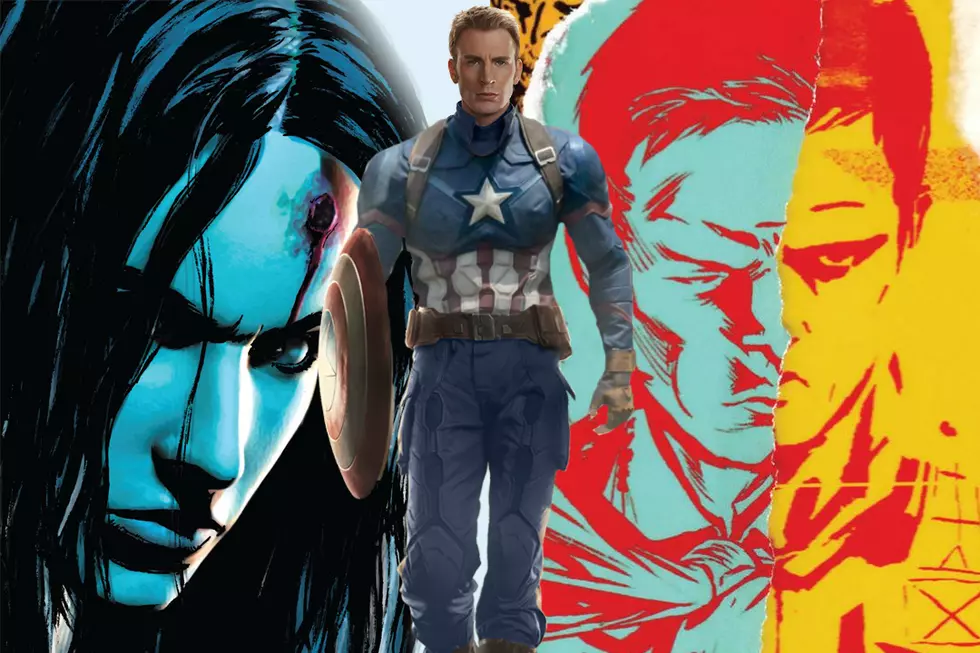
For A Good Time, ‘Dial H': Inside Mieville And Santolouco’s Innovative Cape Comic

As often as it happens in comics, updates are tricky, difficult-to-tame beasts. Any time an old series is dusted off and re-imagined, half the fans are upset that it's not the same as it used to be, and the other half is miffed that it's not new enough. It's difficult for comics to find the balance that pays appropriate respect to what's come before while twisting it and reshaping it for a new audience. When one does attain the perfect equilibrium, it's worth noting. Such is the case with Dial H by China Miéville, Mateus Santolouco, and others. The first trade collection, Dial H: Into You is in stores this week, and it forgoes gritty deconstructionism, maintains what makes the concept great, revamps it without rebooting it, and urges it forward into wider, weirder territories.Even though the concept has never had a big-name hero to go with it (that's kind of the point), and only occasionally had its own series, mostly living through stories in anthology books like Adventure Comics and House of Mystery, "Dial H for Hero" is another great idea from the wacky sixties. With the use of a mysterious device called the H-Dial, users are able to transform themselves into a litany of superheroes, each with their own unique powers. It's been revamped twice before: in the 1980s with new "dial-bearers," and in the 2000s with a complete lack of joy.

In Dial H, the "dial-bearer" is Nelson Jent, and he's in dire need of some self-transformation. A fat, chain-smoking, self-hating loser, Jent is still under thirty and trying to get over a heart attack. His only friend in the world is Darren, a low-level thug who's actually a better-adjusted member of society than Nelson is, who keeps pushing Nelson to get in shape and quit hating himself. When Darren is attacked by his crew for skipping on a job -- because he was helping Nelson -- Jent frantically tries to dial for help in a nearby phone booth, unwittingly operating the H-Dial, and cracking his world open like a bloody egg.
Assuming the powers and identities of several ridiculous heroes, Nelson discovers a writhing, gnashing level of weirdness just behind the veneer of his pathetic life, all connected to the dial. There are other dials and other dial-bearers. One of them, named Manteau, is living in the same town as him, and she's on the case of a "nullomancer" named Ex Nihilo and an alien named Squid. For some reason, they're only interested in coma victims, who are possibly dial-related. And as badly as Nelson wants to quit hating himself and be a hero, the more he uses the dial, the more danger he's in of losing his self-identity entirely.

It's safe to say that Dial H is probably the darkest, weirdest version of "Dial H for Hero" that's ever been on the stands, and it's about as hard to describe as an acid trip. If you're old enough to recall how difficult it was to explain the greatness of Grant Morrison and Richard Case's Doom Patrol only to be met with quizzical stares, you may be in store for some déjà vu. The heroes Nelson invokes are some of the weirdest since the earliest Dial H stories from the sixties, with names like Boy Chimney, the Iron Snail, Baroness Resin, Captain Lachrymose, Shamanticore, Rancid Ninja, and Cock-a-Hoop, all with powers to match.
Miéville, whose imagination has always seemed darkly odd, clearly revels in this aspect of the story, and he and Santolouco throw down weirdo after weirdo, never failing to make you twist your head at their peculiarity. And while a lot can obviously be said about Miéville's skills (if you haven't read any of his novels, get right the hell on that) let's not forget Mateus Santolouco, a versatile, slippery artist whose cartoons are perfectly matched to the material, able to go ridiculous one minute, menacing the next.

But probably the weirdest thing about Dial H is how, unlike every other title in the New 52, it seems more concerned with adding to its continuity rather than restarting it. There are several significant references to the past of "Dial H for Hero" -- so much, it actually seems like the series dovetails with Pre-Crisis canon. In Dial H, Nelson and Manteau live in Littleville, Colorado, a hotbed of dial activity. Which makes sense, considering it's the setting of all the Robby Reed stories of the 1960s. There's an appearance by Gary King, the brother of Chris King, one of the dial-bearers from the 1980s stories, and Squid and the "big bad" actually both first appeared in a classic "Dial" story, from 1983's Action Comics #490.
It's hard to say for sure at this point, but Miéville's approach appears to be the same that Grant Morrison took with Batman's fictional history: everything happened and nothing is ignored. Rather than rebooting like H.E.R.O. did, it draws on the history that's already there, makes it new, and adds gravity and depth. With the constant revising that takes place in the New 52, like a perpetual motion machine spitting out new mythologies, it's refreshing to read something that actually embraces its own past while adding something new.

Within the first seven issues, Miéville and Santolouco delve deeper into the origins of the dial than any previous version has. There's a wealth of unseen history that's being slowly, tantalizingly revealed in these pages. The idea of the H-dial becomes much bigger and greater, without ever detracting from the sheer, weird joy that has always made it sparkle. Sure, there are aphotic, conspiratorial tones, and massive, frightening possibilities making chitinous sounds in the background (that's kinda China Miéville's thing) -- but it's also big, giant comics fun that recalls the pure golden cheer of the earliest "Dial H for Hero" stories.
If you want to see a revamp done right, prefer equal parts light and dark, and don't mind confused looks, then this is the book for you. Dial H for hdamn hfine hcomics.
More From ComicsAlliance



![China Mieville’s ‘Dial H’ Says Final Goodbye With 20-Artist ‘Dial E’ Issue For Villains Month [Special Wordless Preview]](http://townsquare.media/site/622/files/2013/09/Untitled-212.jpg?w=980&q=75)

![‘City Fall’ Tensions Rise In ‘Teenage Mutant Ninja Turtles’ #23 [Preview]](http://townsquare.media/site/622/files/2013/06/tmntongo23-pr-main.jpg?w=980&q=75)
![‘Teenage Mutant Ninja Turtles: Secret History of the Foot Clan’ Wraps With Issue #4 [Preview]](http://townsquare.media/site/622/files/2013/03/tmnt-sotfc-004-pr-main.jpg?w=980&q=75)
![Expand Your Knowledge Of The Known Universe With ‘Dial H’ #10 [Preview]](http://townsquare.media/site/622/files/2013/03/dial-lede.jpg?w=980&q=75)
![Dig Deeper Into The Past In ‘TMNT: The Secret History Of The Foot Clan’ #2 [Preview]](http://townsquare.media/site/622/files/2013/01/tmntfootclan-002-pr-main.jpg?w=980&q=75)
